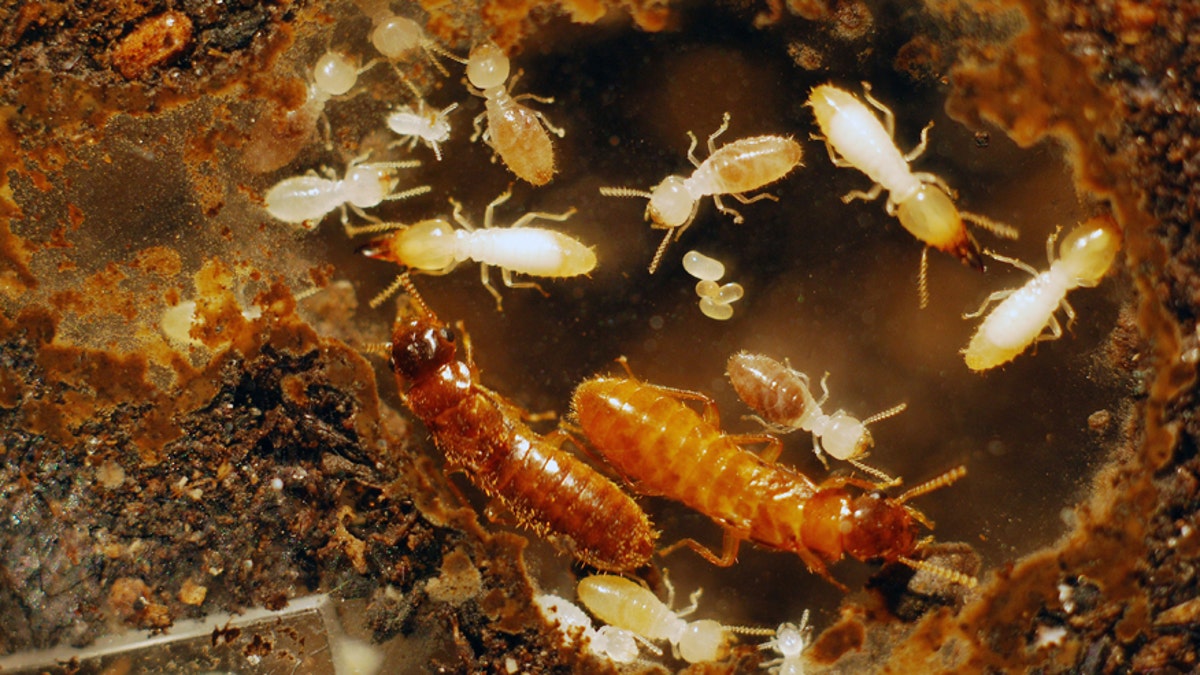
This undated photo provided by Thomas Chouvenc of the University of Florida's Institute of Food and Agricultural Sciences (IFAS), shows young hybrid termite offspring eight months after the light-colored female Formosan termite, bottom right, mated with the darker male Asian termite, bottom left, in Florida. (AP Photo/Thomas Chouvenc, University of Florida/IFAS)
Two of the world’s most destructive termite species are swarming South Florida, and the fact that they are mating has scientists sweating.
The Asian and Formosan subterranean termite species are producing hundreds of thousands of winged males and females (known as alates), which are in turn creating hybrid colonies, according to University of Florida entomologists. The two species are no joke, and hybrid colonies could prove even more disastrous for homeowners.
“They are the two most destructive termite species in the world,” University of Florida Entomology Professor Nan-Yao Su told FoxNews.com. “The common name for Formosan subterranean termite in China and Japan is ‘house termite’ as it can literally bring down a house, usually [starting] with [the] roof as they chew through the supporting beams.”
Termite colonies, sometimes consisting of millions of individuals, can live up to 20 years and thrive in South Florida, where the temperatures offer ideal mating conditions.
Researchers previously believed that the two species had distinct swarming seasons that kept them apart, preventing the risk of interbreeding. However, they are now finding that there is an overlap in seasons in the south of the state, leading to the production of hybrid colonies.
Apparently, the male Asian termites prefer Formosan females to that of their own species – a fact that, according to Professor Su, is due to pheromones. “Both species probably use [the] same chemical for mating,” he said. “But the Formosan female probably produces more mating pheromone than [the] Asian subterranean termite female, hence the Formosan female becomes more attractive. At least that is our working hypothesis.”
The area of the species overlap extends from Miami (Dade County) to Riviera Beach (Palm Beach County).
What makes the emergence of hybrid colonies so alarming is that they’re reproducing at a rate that is more than twice as fast as the parent species. Known as “hybrid vigor,” this offers a few troubling scenarios: that the hybrid colonies could reach maturity faster (two to three years, as opposed to the parent species maturing in five to six), or that they could form a much larger colony (5 million to 10 million termites per colony, as opposed to 2 million to 5 million).
Either way, Su said, it’s bad news: “We don’t know if the hybrid individual can consume more wood, but these are parameters we need to study. At any rate, any of one of these, if proven correct, could mean more destructive termites.”
This doesn’t only spell trouble for South Floridians. With the hybrid colonies reproducing at a much faster rate and growing to larger numbers, the possibility of them spreading to other states is that much greater.
According to Su, this will depend on the hybrid’s fertility. “Due to its tropical distribution, Asian subterranean termites probably won’t go any further than Palm Beach County. If the hybrid offspring is sterile, then the hybrid population will most likely [be] restricted to South Florida. However, if the hybrid offspring is NOT sterile, and it has the temperature tolerance of both parent species, then we may see them expanding from North Carolina to Brazil.”
The Asian and Formosan termites are no strangers to world travel. The Formosan termite originated in China, but is now firmly entrenched in the southeastern U.S. Even more widespread are the Asian termites, which have managed to spread to Brazil and the Caribbean islands. The species invade foreign soil by hitching rides on wooden boats or by stowing away in shipped wooden crates.
Currently, homeowners can use baits or apply insecticides in the dirt surrounding their houses to halt or prevent infestation. With the emergence of these new hybrid colonies, it may be time to stock up.
